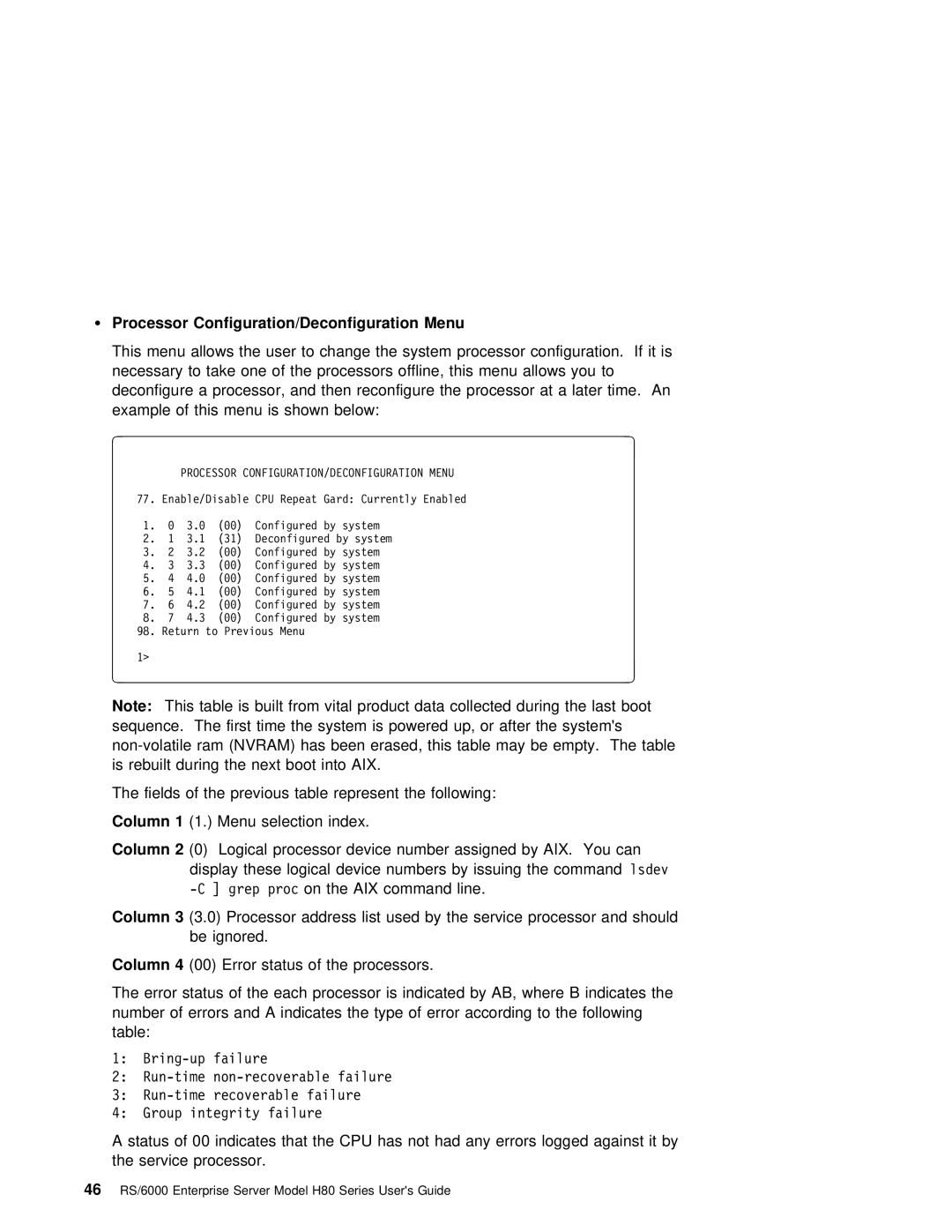ŸProcessor Configuration/Deconfiguration Menu
This menu allows the user to change the system processor configuration. If it is
necessary to take one of the processors offline, this menu allows you to deconfigure a processor, and then reconfigure the processor at a later time. An example of this menu is shown below:
|
|
|
|
|
|
|
|
|
|
|
|
|
|
|
|
|
|
|
|
|
|
|
|
|
|
|
| à |
|
| PROCESSOR CONFIGURATION/DECONFIGURATION MENU |
|
|
| ð |
|
|
|
|
|
|
|
| ||||||||||
|
|
|
|
|
|
|
|
|
|
|
|
| ||||||||||||||
|
|
|
|
|
|
|
|
|
|
|
|
|
|
|
|
|
| |||||||||
| 77. | Enable/Disable CPU Repeat Gard: Currently Enabled |
|
|
|
|
|
|
|
|
|
|
|
|
| |||||||||||
|
|
| 1. | ð | 3.ð | (ðð) | Configured by system |
|
|
|
|
|
|
|
|
|
|
|
|
|
|
| ||||
|
|
| 2. | 1 | 3.1 | (31) | Deconfigured by system |
|
|
|
|
|
|
|
|
|
|
|
|
|
|
| ||||
|
|
| 3. | 2 | 3.2 | (ðð) | Configured by system |
|
|
|
|
|
|
|
|
|
|
|
|
|
|
| ||||
|
|
| 4. | 3 | 3.3 | (ðð) | Configured by system |
|
|
|
|
|
|
|
|
|
|
|
|
|
|
| ||||
|
|
| 5. | 4 | 4.ð | (ðð) | Configured by system |
|
|
|
|
|
|
|
|
|
|
|
|
|
|
| ||||
|
|
| 6. | 5 | 4.1 | (ðð) | Configured by system |
|
|
|
|
|
|
|
|
|
|
|
|
|
|
| ||||
|
|
| 7. | 6 | 4.2 | (ðð) | Configured by system |
|
|
|
|
|
|
|
|
|
|
|
|
|
|
| ||||
|
|
| 8. | 7 | 4.3 | (ðð) | Configured by system |
|
|
|
|
|
|
|
|
|
|
|
|
|
|
| ||||
| 98. | Return to Previous Menu |
|
|
|
|
|
|
|
|
|
|
|
|
|
|
|
|
| |||||||
| 1> |
|
|
|
|
|
|
|
|
|
|
|
|
|
|
|
|
|
|
|
|
|
|
| ||
| á |
|
|
|
|
|
|
|
|
|
|
|
|
|
| ñ |
|
|
|
|
|
|
|
| ||
|
|
|
|
|
|
|
|
|
|
|
|
|
|
|
|
|
|
|
|
|
| |||||
|
|
|
|
|
| |||||||||||||||||||||
Note: |
| This | table is built from vital product data collected during the last boot | |||||||||||||||||||||||
sequence. The | first time the system is powered | up, or after | the | system's | ||||||||||||||||||||||
ram | (NVRAM) has been erased, this | table | may | be | empty. The | table | ||||||||||||||||||||
is | rebuilt | during | the | next boot | into | AIX. |
|
|
|
|
|
|
|
|
|
|
|
| ||||||||
The | fields |
| of | the previous | table | represent | the following: |
|
|
|
|
| ||||||||||||||
Column | 1 | (1.) | Menu | selection | index. |
|
|
|
|
|
|
|
|
|
|
|
|
| ||||||||
Column | 2 |
| (0) Logical processor device number assigned by AIX. You can |
|
| |||||||||||||||||||||
|
|
|
|
| display these | logical | device | numbers | by | issuinglsdev the | command |
|
|
| ||||||||||||
|
|
|
|
|
|
|
|
|
|
|
|
|
|
|
|
| ||||||||||
Column | 3 |
| (3.0) | Processor | address | list | used | by | the |
| service | processor | and should | |||||||||||||
|
|
|
|
| be | ignored. |
|
|
|
|
|
|
|
|
|
|
|
|
|
|
|
|
| |||
Column | 4 |
| (00) | Error | status | of | the | processors. |
|
|
|
|
|
|
|
|
|
|
| |||||||
The | error | status of the each processor is | indicated | by | AB, | where | B | indicates th | ||||||||||||||||||
number |
| of | errors | and | A indicates | the | type | of | error | according | to | the | following | |||||||||||||
table: |
|
|
|
|
|
|
|
|
|
|
|
|
|
|
|
|
|
|
|
|
|
| ||||
1:
2:
3:
4:Group integrity failure
A status of | 00 indicates that the CPU has not had any errors logged against it by |
the service | processor. |
46 RS/6000 Enterprise Server Model H80 Series User's Guide
